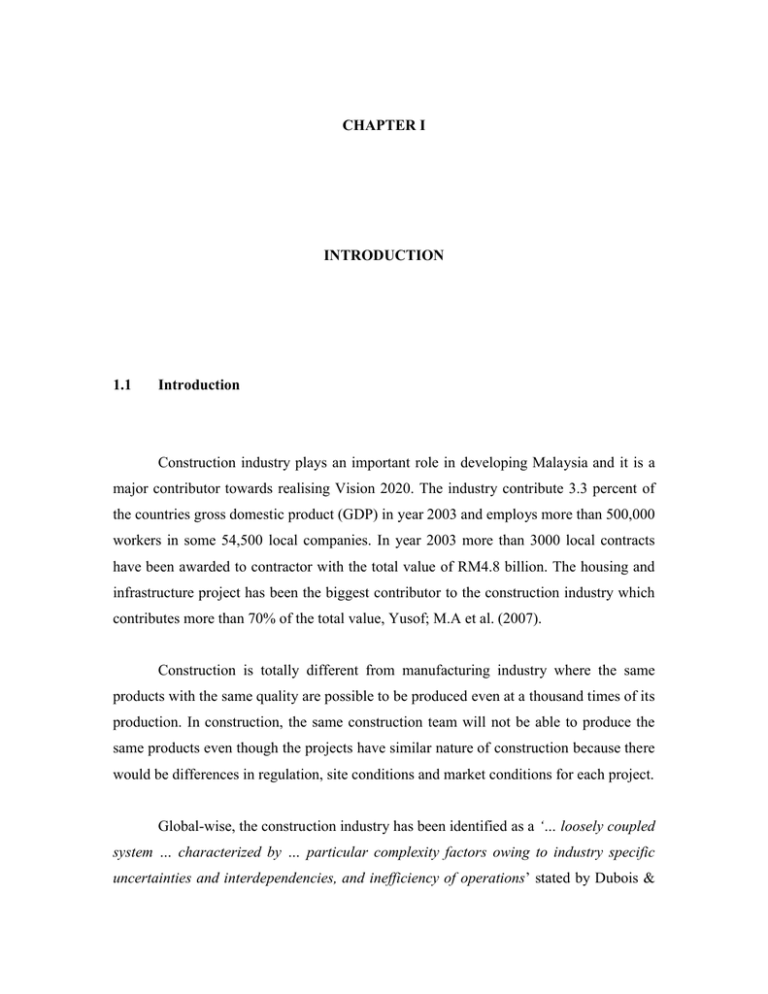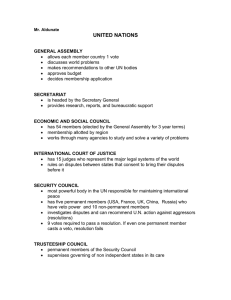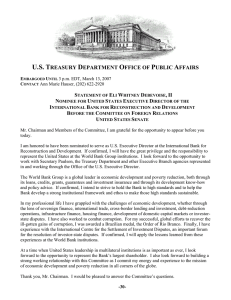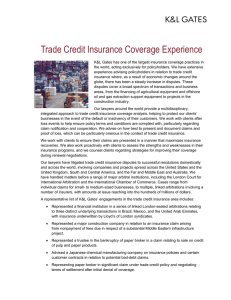1 CHAPTER I INTRODUCTION 1.1
advertisement

1 CHAPTER I INTRODUCTION 1.1 Introduction Construction industry plays an important role in developing Malaysia and it is a major contributor towards realising Vision 2020. The industry contribute 3.3 percent of the countries gross domestic product (GDP) in year 2003 and employs more than 500,000 workers in some 54,500 local companies. In year 2003 more than 3000 local contracts have been awarded to contractor with the total value of RM4.8 billion. The housing and infrastructure project has been the biggest contributor to the construction industry which contributes more than 70% of the total value, Yusof; M.A et al. (2007). Construction is totally different from manufacturing industry where the same products with the same quality are possible to be produced even at a thousand times of its production. In construction, the same construction team will not be able to produce the same products even though the projects have similar nature of construction because there would be differences in regulation, site conditions and market conditions for each project. Global-wise, the construction industry has been identified as a ‘… loosely coupled system … characterized by … particular complexity factors owing to industry specific uncertainties and interdependencies, and inefficiency of operations’ stated by Dubois & 2 Gadde (2002). The separation between the design and construction processes, the fragmentation evident in the management of the construction process by subcontract, and the short term project focus of the contractual relationships between participants results in little incentive or opportunity to improve inter-organizational practices. With respect to this, there are various participants in this industry. These included; clients, regulatory agencies, engineers, quantity surveyors, developers, lawyers, suppliers, contractors, architect and the list goes on. Their obligations and objectives varied, based on their contractual relationship for each projects. Owing to this complex, fragmented nature of this industry, disputes between different parts within these interacting fragments is highly foreseeable. 1.2 Problem Statement Dispute in construction industry may it be in the form of financial , legal or any other form is an important subject that requires attention of the industry ‘players’. Within the scope of the industry itself, disputes most often than not leads to losses may it be in terms of economic, time, market share as well as reputation, and in certain extreme cases may even lead to the downfall of a construction entity. According to Groton (1997); Mitropoulos and Howell (2001), J.G Richard (2006), evidence showed that the amount of disputes on construction projects can be reduced through dispute identification. There are many who believe that conflicts, and therefore disputes, injured business relationships. Many considered that disputes in the construction industry are inevitable stated by Cheung and Suen (2002); Stipanowich (1996), J.G Richard (2006). Thus, it essential that all participants within this very fragmented industry must consider and establish a proper and effective mechanism to minimise disputes, to ensure products of total quality and value can be achieved and delivered. The topic on minimisation construction disputes also dawned from newspaper articles entitled ‘Precinct 11 Housing Project at a Standstill’,published in The STAR 3 Newspaper dated May 8, 2008. It was about the disputes between the Client, Putrajaya Holdings Sdn Bhd (PJH) and the Contractor, Peremba Jaya Sdn Bhd. The disputes has been kept in silence for the last two years. Out of the total of 259 units offered, 211 units or equivalent to 81.5% has been sold. The project was promised to be delivered to the buyers in 2005. The bulk of the project was originally given by Peremba Jaya Sdn Bhd to its subsidiary, Arif Cerah Sdn Bhd who eventually got into financial difficulties in 2005 which causes the project to be stalled. To date Arif Cerah Sdn Bhd has surrendered the land title back to Putrajaya Holdings to resume the work. As a result, customers who have purchased the house by signing the sales and purchase agreement as early as 2003 has been servicing their housing loan repayment to the bank are the victims of the disputes. Furthermore, in relation to these negative impacts or consequences that disputes can bear towards the industry, therefore it is vital that participants or ‘the players’ within this industry adopt a serious attitude towards mastering this subject matter, which in turn would assists them in planning, decision-making and implementation of construction projects. This research, will address as much as possible the issues, facts and ideas regarding the matter of disputes in construction industry and its minimization strategies. 1.3 Aim of Study The aim of this study is to determine the causes of dispute in the local construction industry and to identify strategies to mitigate the disputes. To achieve the above aim, the following objectives have been identified. 4 1.4 Objective of Study In order to achieve the above aims, following objectives have been laid out: 1) To identify the causes for dispute in the construction industry. 2) To study the effect of disputes in the construction industry 3) To identify ways to mitigate disputes in construction. 1.5 Scope of Research With respect to the very vast subject regarding disputes in industry, therefore, this particular work will focus on several types of disputes that are commonly experienced within the industry. Subsequently, the consequences arising from these disputes will also be addressed, and where possible supported with actual case examples. Next, the study will also put forward the strategies to minimize these disputes, based on established ideas from various references, journal, articles, working papers and newspapers. Finally it should also be noted that all the issues, facts, ideas as well as proposal that will be presented in this study will only focused on those related to the scenario of construction industry. 5 1.6 Significance of Research The subject matter of disputes is an important subject that participants within construction industry needs to be aware of, and understands as clear as possible, Thus, this study is presumed to bear the significance of compiling the relevant knowledge regarding the minimizations of disputes whereas the final product (the completed work as a literature) may be used as a source of reference for all who are involved in construction industry or the construction processes to enhance their knowledge on the matter of disputes together with strategies to minimize it. This would subsequently assists everyone involved towards a more calculated planning, implementation and decision-making, by taking into account the potential risks of disputes and ways to resolve it if encountered – in short; of how to adopt a proper and effective strategies to minimize and resolve disputes. 1.7 Research Methodology In order to complete this dissertation, the first and foremost step of the study was identifying research problem which covered the significance, objective and scope of study. Second step is then followed by exploratory research of the literature. Secondary data sources for literature review are gathered from references books, journals, newspaper articles and relevant magazines. These sources provide lots of data that can help to determine the background of the research. Primary data gathered for this study are taken from interviews conducted with the expert in this industry. Questionnaires are also distributed among the participants in construction industry. All the data will analysed using statistical method. Figure 1.1 shows methodology flowchart for this research. 6 Figure 1.1 Methodology Flowchart



